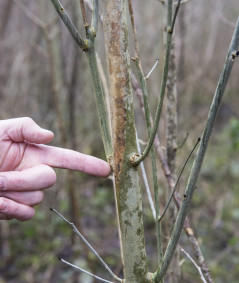Ash dieback disease: A plague on our ashes
Posted on February 8, 2016 by Dr Anne Edwards & Prof Allan Downie
Ash dieback is expected to kill millions of Britain’s ash trees over the next ten years. Caused by a fungus, Hymenoscyphus fraxineus, the disease kills trees by spreading through the branches and strangling the vascular system.

Dr Anne Edwards and Prof Allan Downie study ash dieback at the John Innes Centre in Norwich. We revisit the woodland where Anne first found ash dieback in 2012 to see how some trees seem to be tolerant to the fungus, and learn what’s being done in the fight against the disease.
The following is an extract from an article in Microbiology Today. You can read the full article here.
A plague on our ashes
In late autumn 2012, it became evident that ash dieback disease had become established in native woodlands in the eastern regions of the UK. This was the leading edge of an epidemic that had already swept east to west across mainland Europe over a period of about 20 years.
We were aware of the disease because of our involvement in helping manage Ashwellthorpe Lower Wood, an ancient coppiced woodland in South Norfolk. This woodland, owned by the Norfolk Wildlife Trust, is a Site of Special Scientific Interest (SSSI) and its name, Ashwellthorpe, comes from the Vikings, for whom the ash (Fraxinus excelsior)was sacred. It was devastating to see young coppiced regrowth showing early signs of what looked like ash dieback. Since this occurred just a few miles from where we work at the John Innes Centre (which specialises in plant and microbial research), we asked ourselves and our colleagues what we could do to help an iconic native tree.
As a first step, we extracted and tested DNA from infected branches and our fears were confirmed: the trees were infected with the fungus Chalara fraxinea, the causal agent of ash dieback. Symptoms of the disease include the wilting (dieback) of young leaves in spring, dying of leaves in late summer while they are still attached to the tree, lesions and cankers on stems and branches, and dieback of the crown. Young saplings and coppice regrowth can succumb quite rapidly, some within one growing season. Older trees can survive an initial attack but many stop growing and may become prone to secondary infections. In other parts of Europe, over 90% of the ash trees were killed or severely affected by the disease, so there was an outcry in the UK as the general public and media realised that this iconic tree may disappear from our landscape.
Genomics of host and pathogen
With funding from the BBSRC and Defra, a research consortium called Nornex (http://nornex.org/) was set up including groups from the John Innes Centre, The Sainsbury Laboratory and The Genome Analysis Centre (all in Norwich), the Universities of Exeter, Edinburgh and York, FERA, Forest Research, the University of Copenhagen, and the Norwegian Forest and Landscape Institute. The aims were to (a) use genomics-based tools to establish a foundation of knowledge on the pathogen, (b) establish laboratory-based tests of pathogenicity and assays of growth and survival of the pathogen, and (c) use genomics and transcriptome-based approaches in ash trees to try to map tolerance (resistance) to the disease.
These aims were underpinned by a desire to try to take a different approach and use an open access and crowdsourcing approach. As part of that, a website called openashdieback (http://oadb.tsl.ac.uk/) was established to host new observations and provide access to data generated by the consortium. In view of the intense public interest, we also developed and released Fraxinus, a Facebook-based citizen science genomics-based game (https://apps.facebook.com/fraxinusgame/). This enabled non-specialists to contribute to the genomic studies of the pathogen by helping to improve genetic variant predictions from DNA sequence alignments. Many computer programs have been devised to optimise alignments. However, none can improve on the pattern recognition skills of the human eye. Once an alignment process is complete, genetic variations such as single nucleotide polymorphisms (SNPs) or insertion-deletion polymorphisms (INDELs) can be identified and further studied in relation to alterations in, for example, pathogenicity.
The research
Three years on and what has been achieved? We have a good genome sequence of H. fraxineus, revealing that it does not contain the great diversity of genes for wood degradation like those used by wood-rotting fungi, but it does possess cell wall-degrading enzymes such as cellulases and pectate lyases used for cellular penetration. It also synthesises toxins, effectors and predicted protein inhibitors to help it evade plant defences. Genome sequencing of different isolates has revealed that there is less genetic diversity in European isolates than in Asian isolates and it seems highly likely that the original H. fraxineus came from Asia. We have preliminary data from the sequencing of tree leaf RNA, identifying potential genetic markers that could be associated with inheritance of tolerance to the disease. We believe that we have established a framework that will enable us to predict which trees will be tolerant to the disease, to understand the nature and diversity of the pathogen, and to carry out laboratory-based tests of pathogenicity in tree seedlings. All of these can be used to rebuild a genetically diverse population of trees tolerant to this disease that, over time, will probably kill or severely damage 80–90% of the UK ash tree population.
